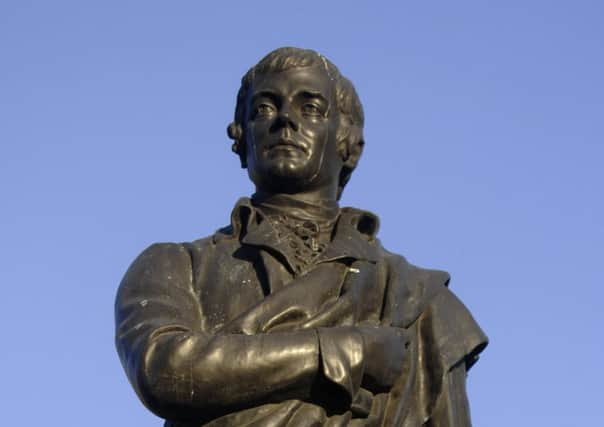Martyn McLaughlin: Scotland is undervaluing its most famous son


My first job in journalism was happily spent roaming Robert Burns country. I was in the post for just six months, but during that time, I retraced the bard’s footsteps, and realised it was a part of Scotland home to an untapped wealth of stories.
At the time, some of the most high-profile Burns pilgrimage sites were in dire straits. I wrote about the dilapidated state of Alloway’s Auld Kirk, the graveyard where Burns buried his father, and the setting for the supernatural dance in Tam O’Shanter, where Satan led a gaggle of warlocks and witches in a jig “till roof and rafters a’ did dirl”. It was in such a torrid state of disrepair that the bell tower was removed to prevent it collapsing altogether.
Advertisement
Hide AdThe nearby Burns Cottage, the poet’s birthplace, was an eyesore of its own, with the precious Burns family bible suffering severe water-damage thanks to an unnoticed leak in its roof. What was supposed to be a landmark visitor attraction was a sorry and shameful sight.
Thankfully, funding packages were secured for both sites and their precious artefacts, but there remained a sense that the authorities were doing the bare minimum to safeguard internationally significant, cultural heritage.
Our understanding and appreciation of the irreplaceable value of such sites has come on a great deal since then, evidenced by the welcome news that Glasgow University’s Centre for Robert Burns Studies is to produce a comprehensive report exploring the economic value of Scotland’s national bard.
The initiative, led by Professor Murray Pittock, will drill down into how the ongoing “worldwide fascination” with Burns not only enriches Scotland’s cultural standing, but directly benefits national and local economies.
Assigning a definitive worth to the Burns industry may seem unpalatable to those who believe we should be focusing on the values this son of the soil stood for, but the two are not mutually exclusive. Establishing exactly how Burns benefits our economic, as well as cultural, life will make it easier to convince funding bodies of the ongoing need to preserve his tourist trail.
The good news is that the assessment, which will run until next summer, is starting from a position of strength. Burns Cottage – nowadays better known as the Robert Burns Birthplace Museum, and cared for by the National Trust for Scotland – is bettered only by the Shakespeare Birthplace Trust in Stratford-upon-Avon when it comes to footfall for a museum dedicated to a single writer.
Advertisement
Hide AdYet there has been a persistent nagging sense for years, if not decades now, that Scotland can and should be doing more to promote Burns.
The Glasgow University study is nothing if not overdue. It has been 15 years since the last substantial study of the economic boost provided by the Burns legacy.
Advertisement
Hide AdBack then, Lesley Campbell, an economic consultant at the World Bank, suggested as much as £159 million was being spent every year by tourists in search of Rabbie’s essence. The lion’s share consisted of accommodation, transport, and spending in cafes and restaurants, with the remainder going on merchandising, haggis, and whisky.
Two years later, Professor John Lennon at Glasgow Caledonian’s Moffat Centre for Travel and Tourism Business, produced his own analysis, which was broadly similar to that of Ms Campbell. He put the figure at £157m, but in a sign of the inexact science behind such research, he admitted it could be “three or four times that figure”.
Whatever the number, Mr Lennon was insistent that Scotland was failing to reap what its most famous son had sowed.
“The brand value of Burns really is the sleeping giant of Scotland,” he observed. “If you are looking for a major national literary figure in a country, you would be lucky to have a Burns. I think sometimes Scotland is too self-critical and modest.”
Whatever the reason, the experience of the past few decades proves Mr Lennon was right.
The 1996 bicentenary of Burns’ death was an opportunity missed, and the Homecoming Scotland events of 2009 put far too little emphasis on the great man’s life and work. Thoughtful and original ideas which emerged, such as Robyn Marsack’s project exploring Burns’ relationship with agriculture, were denied funding.
Advertisement
Hide AdWhile modern gatherings such as the Burns an’ a’ That Festival and the Big Burns Supper have been notable successes, they are the exception.
The Glasgow University research will hopefully concentrate minds on the importance of Burns to our tourism industry. Its findings must be seized upon and interpreted.
Advertisement
Hide AdWay back in 1991, the then Kyle & Carrick District Council and Enterprise Ayrshire, mindful that they should be doing more to promote the Burns attractions on their doorstep, had their own lightbulb moment, and commissioned Cobham Resource Consultants to look into the issue.
Their subsequent report highlighted a lack of co-ordinated action and concluded that the Burns story needs to be communicated far more effectively to visitors. There were lessons learned from that study, though just as many have been forgotten.
There are numerous heritage trails to Burns in Ayrshire, Galloway, and further afield, all of which do fine work in guiding and informing visitors. But surely it is time for a national trail to unify and celebrate the achievements of our most famous son?
